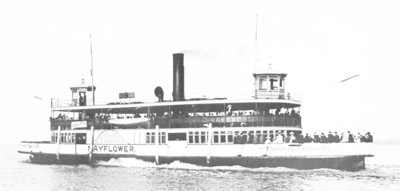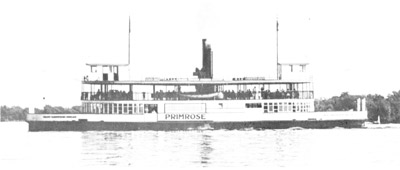Table of Contents
During the one hundred and forty years that have passed since the horseboat SIR JOHN OF THE PENINSULA first crossed Toronto Bay in 1833 to what is now Toronto Island, many ferries have operated on these waters. Possibly two of the most famous and popular ferries on the route have been the double-ended sidewheelers MAYFLOWER (Can. 94987) and PRIMROSE (Can. 94990). Sister ships, they were built for the Toronto Ferry Company in 1890 by the Doty Engine Company from the designs of W. E. Redway.
The Toronto Ferry Company Ltd. was registered as a joint stock company on February 27th, 1890, capitalized at $250,000. One of the main purposes of the new company was to take over the Doty Ferry Company. Doty Brothers had purchased the ferry fleet of Capt. John Turner on April 9th, 1887 for just $14,600.

MAYFLOWER is shown leaving Hanlan's Point in this early photo.Note the original pilothouses, fancy paddleboxes, and decorative paintwork.
The President of the new Toronto Ferry Company Ltd. was Mr. E. B. Osler and William Hendrie was Vice-President. The company's office and board room were located at 18 King Street West, Toronto. The Toronto Evening Telegram commented, "There is no better evidence of how well they do what they undertake to do than the fact that no one ever hears anything about them or their affairs."
MAYFLOWER and PRIMROSE were the first vessels built for the Toronto Ferry Company, although actually the principals of the firm let the contract for the construction of the new ferries a full month before incorporation took place. MAYFLOWER was launched May 24, 1890 and was christened by Miss Jennie Doty. PRIMROSE followed her sister into the waters of Toronto Bay on June 28, 1890 under the sponsorship of Miss Mary Williams who was the daughter of the Commodore of the Toronto Ferry Company's fleet. Many of the Toronto ferries were named for common flowers and the new steamers were no exception to this practice which lasted up until the building of SHAMROCK (II) in 1935.
The ferries cost $33,000 each and their dimensions were identical: length 140.2', beam inside the guards 28.2', and depth 6.8'. Tonnage was 189 Gross, 119 Net. The hulls were of steel up to the main deck while the upperworks were of wood. Power was supplied by diagonal direct acting 29 H.P. engines by Doty and boilers were coal-fired. Each ferry was licensed to carry 900 passengers.

This August 1938 photo by J. H. Bascom shows PRIMROSE after rebuilding. She is Citybound from Hanlan's Point in her last month of service.
The Toronto Evening Telegram, in describing the new wonders of Toronto Bay, said "Both these steamers are lighted throughout by electricity, and when loaded with pleasure seekers at night, present a gay and unique appearance. They are invariably considered the finest ferry steamers to be found between Hudson's Bay and the Gulf of Mexico." Compared with the other Island ferries of their day, MAYFLOWER and PRIMROSE were far superior. They were equipped originally with colorful octagonal "bird cage" pilothouses which were so popular in the Nineties. The windows on the main deck and in the pilothouses were in two sections, the large lower pane being of clear glass while the small upper section was fitted with stained glass. The paddleboxes were elaborately decorated and the painters ran wild in their treatment of lettering and window frames.
As originally built, the ferries were boarded via side gangways on the main deck, although they appear to have been planned with the idea of end loading in mind. With the opening of the new ferry terminal at the foot of Bay Street in July 1906, gangways were fitted at both ends. In addition , to take care of the large volume of passenger traffic as quickly as possible, an upper platform and gangway leading from the upper deck to the second storey of the terminal building was developed. This upper deck loading system must have had its drawbacks and it did not last long. When the Bay Street terminal was badly damaged by fire in 1918, the structure was rebuilt without facilities for upper deck gangways.
After approximately twenty-five years of service, MAYFLOWER and PRIMROSE were updated by the removal of the original octagonal pilothouses. These were replaced by square box-like structures with three large windows across the front and containing an officers' cabin as well as the wheelhouse, Also it was about this time that the stained glass upper window sections were reglazed with clear glass and square paddleboxes replaced the curved and ornate original housings,
MAYFLOWER seems to have been involved in very few accidents during her forty-eight years of service as a ferry, but PRIMROSE was not so lucky. On August 13th, 1916, PRIMROSE was in collision with the Toronto-Hamilton passenger steamer TURBINIA. While approaching the Bay Street terminal on the evening of that day, she was struck by TURBINIA which was proceeding from her Toronto dock to the coaling wharf in preparation for the next day's run. The collision was investigated by the Dominion Wreck Commissioner, Capt. L. A. Demers, who was noted for his highly critical assessments and severe judgments. Capt. B. W. Bongard of the TURBINIA had his license suspended for one year as he was found "in default for not ordering any reduction in speed when he found his one-whistle passing signal went unanswered by PRIMROSE." Capt. Alex Brown of PRIMROSE drew Capt. Demers' caustic ruling that he was "incompetent as a master because he seemed to have his entire thought centred on making the dock and maintaining his schedule." His master's license was permanently revoked although it was recommended that he be given a mate's license on a freight boat after one year.
MAYFLOWER and PRIMROSE were in collision with each other at 10:20 p.m. on August 4, 1924, that day being a Monday holiday known in the city as Civic Holiday. Operating on the Centre Island route in foggy weather, MAYFLOWER struck her sister on the paddlebox, disabling PRIMROSE'S wheel. MAYFLOWER took the 150 passengers from the other steamer to the mainland terminal and then returned to the scene, towing her sister back to the dock. Once again Capt. Demers investigated, finding both masters to have been in error.
Back on August 6th, 1907, MAYFLOWER very nearly became a fire casualty. At 1:55 a.m. that summer day, the Toronto Fire Dept. received a call to the effect that the old ferry SHAMROCK (I) was on fire in the west slip at the Bay Street ferry docks. SHAMROCK had been out of service since 1905 and by the time firemen arrived at the scene, she was ablaze from stem to stern. In addition, the flames had spread to the new ferry dock and terminal building which had only been completed in July 1906. MAYFLOWER was moored close to SHAMROCK and would have been destroyed if the TURBINIA, which had arrived in port only one hour earlier, had not pulled MAYFLOWER away from her dock and extinguished the smouldering fires in her woodwork.
The Toronto Ferry Company Ltd. was formally taken over by the City of Toronto on November 1st, 1926, with the payment of $337,500 to Lawrence Solman and the Ferry Company for the T.F. Co.'s property, real and floating. However, Mr. Solman remained as operator until February 21st, 1927 on which date the City of Toronto handed over operation of the ferries and the amusement park at Hanlan's Point to the Toronto Transportation Commission. This latter organization had been formed in 1921 to take over the city's public transit system which had been operated by the privately owned Toronto Railway Company. Thus from 1927 the ferries operated under the same management as the street railways.
MAYFLOWER and PRIMROSE continued their faithful service on Toronto Bay until they were retired from service on August 30th, 1938, their condition having deteriorated appreciably. During the last few years, PRIMROSE had suffered upper deck problems and in the makeshift repair process new seating accommodations were installed. The old benches which had been placed around the rail (not too handily situated for anyone aspiring to look out over the side of the ship) were removed and replaced by small double-sided benches which were later transferred to the diesel SAM McBRIDE which was built in 1939 to replace the two aging sisters. They are still in use on this vessel.
The last few weeks of the summer of 1938 were difficult for MAYFLOWER. She was forced to operate as a "single-ender" because her main deck had become loosened from the hull at one end as a result of a severe bump when docking! Presumably management did not go out of its way to bring this condition to the attention of the steamship inspectors.
Late in 1938, both veteran ferries were sold to the Russell Construction Company Ltd, of Toronto for $1500. During the following winter they were stripped to the main deck at Russell's docks on Toronto's Keating Channel and after the removal of upperworks, boilers and engines, the two hulls were redecked for use as barges. MAYFLOWER became R.C.C. 26 while PRIMROSE was renamed R.C.C. 25. No doubt they proved useful since they were seen in these parts for over a decade carrying various loads, but they were certainly most unusual in appearance due to their sharp ends and narrow beam. Both hulls were finally scrapped in the late 1950's at a time when the last of the big sidewheel ferries, BLUEBELL and TRILLIUM, were also sent into retirement. Back in 1938, one of the Toronto daily newspapers had published photos of the then still operating MAYFLOWER and PRIMROSE under the headline "Flowers of the Bay Fade and Die," a prophecy that was to prove only too true.
Previous Next
Return to Home Port or Toronto Marine Historical Society's Scanner
Reproduced for the Web with the permission of the Toronto Marine Historical Society.